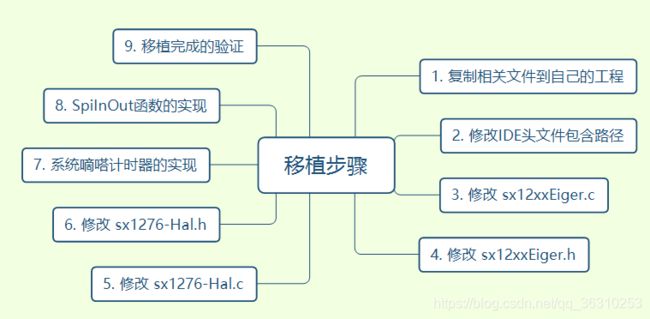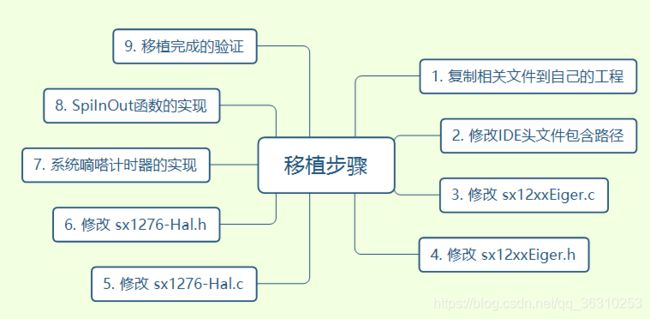LoRa官方驱动源码移植-SX127x
文章目录
- 1. 建立STM8L052的工程
- 2. 拷贝与 sx1278 相关的文件到自己的工程文件夹下
- 3. 修改 platform.h文件
- 4. 修改IAR工程头文件包含路径
- 5. 修改 sx12xxEiger.c
- 6. 修改 sx12xxEiger.h
- 7. 修改 sx1276-Hal.c
- 8. 修改 sx1276-Hal.h
-
- 8.1 sx1276-Hal.h
- 8.2 定时器中断函数
- 9. SpiInOut 函数的实现
-
- 9.1 spi.h
- 9.2 spi.c
- 10. 移植完成的验证
-
- 10.1 main.c的实现
- 11. 总结
LoRa官方固件下载链接 LoRa固件源码 https://download.csdn.net/download/qq_36310253/11974427
本次使用的是sx1278的LoRa芯片,MCU是STM8L052R8,sx1276、sx1277和sx1278只是中心频率有所不同,适用于不同的国家和地区,亚洲地区使用的是sx1278,不同芯片使用的官方固件库是一个,不同芯片区别如下

MCU和LoRa模块的连接原理图如下所示:

本文以IAR建立工程为例,讲述LoRa官方驱动的移植步骤,详细的移植步骤如下:

1. 建立STM8L052的工程
首先以官方固件库建立 STM8L052的工程,直至编译不出错或者可以点亮LED灯为止,证明自己建立的工程没有问题可以对MCU进行操作,本步骤的具体操作不再描述。
2. 拷贝与 sx1278 相关的文件到自己的工程文件夹下
将官方固件包中的 platform 文件夹下的 fifo.c、sx1276-Hal.c、sx12xxEige.c 及相关的 .h 和 platform.h 文佳拷贝到自己的文件目录下,我这里定义的是platform文件夹,拷贝完成如下所示 。

将官方固件包中的radio文件夹下的radio.c、sx1276-Lora.c、sx1276.c、sx1276-Fsk.c、sx1276-FskMisc.c、sx1276-LoraMisc.c及相关的.h文件拷贝到自己的文件目录下,我这里定义的是radio文件夹,拷贝完成如下图所示。

拷贝完成的工程目如下图所示:
3. 修改 platform.h文件
platform.h是平台相关头文件,里面定义了具体使用的是哪一个芯片型号,类似于STM32F1系列中的 stm32f1xx.h 文件,修改后的platform文件如下图所示。
38行定义了 PLATFORM 为 SX12xxEiger,然后在45-48行依据自己的LoRa芯片型号打开相应的宏定义(此宏在 radio.c 中的 RadioDriverInit 函数中使用,对应不同的芯片型号执行不同的初始化、发送和接收操作),本次使用的是sx1278,所示打开47行的宏定义。
因为本次使用的是sx1278芯片,所以要把54-61行的注释全部去掉,在60行定义了 sx12xxEiger.h 这个头文件的路径,需要依照自己实际工程的文件路径进行修改。
#ifndef __PLATFORM_H__
#define __PLATFORM_H__
#ifndef __GNUC__
#define inline
#endif
/*!
* Platform definition
*/
#define Bleeper 3
#define SX1243ska 2
#define SX12xxEiger 1
#define SX12000DVK 0
/*!
* Platform choice. Please uncoment the PLATFORM define and choose your platform
* or add/change the PLATFORM definition on the compiler Defines option
*/
#define PLATFORM SX12xxEiger
#if( PLATFORM == SX12xxEiger )
/*!
* Radio choice. Please uncomment the wanted radio and comment the others
* or add/change wanted radio definition on the compiler Defines option
*/
//#define USE_SX1232_RADIO
//#define USE_SX1272_RADIO
#define USE_SX1276_RADIO
//#define USE_SX1243_RADIO
/*!
* Module choice. There are three existing module with the SX1276.
* Please set the connected module to the value 1 and set the others to 0
*/
#ifdef USE_SX1276_RADIO
#define MODULE_SX1276RF1IAS 0
#define MODULE_SX1276RF1JAS 0
#define MODULE_SX1276RF1KAS 1
#endif
// #include "sx12xxEiger/sx12xxEiger.h"
#include "./sx12xxEiger.h" // 2019-11-14 by lzj 修改sx12xxEiger.h的路径
#define USE_UART 0
#elif( PLATFORM == SX12000DVK )
/*!
* Radio choice. Please uncomment the wanted radio and comment the others
* or add/change wanted radio definition on the compiler Defines option
*/
//#define USE_SX1232_RADIO
//#define USE_SX1272_RADIO
#define USE_SX1276_RADIO
//#define USE_SX1243_RADIO
#include "sx1200dvk/sx1200dvk.h"
#elif( PLATFORM == SX1243ska )
#elif( PLATFORM == Bleeper )
#define USE_SX1272_RADIO
#include "bleeper/bleeper.h"
#define USE_UART 0
#else
#error "Missing define: Platform (ie. SX12xxEiger)"
#endif
#endif // __PLATFORM_H__
4. 修改IAR工程头文件包含路径
修改头文件包含路径,将路径指定为自己建立的文件夹下
|-> options
|-> c/c++ compiler
|-> Preprocessor
|-> 在Additional include direc中添加 $PROJ_DIR$/../radio
$PROJ_DIR$/../sx12xxEiger
接下来就是和具体板子相关的修改,具体修改LoRa模块和板子连接的引脚部分内容的修改,具体的修改办法是编译工程找出错误的文件进行相应修改,详细修改过程如下:
5. 修改 sx12xxEiger.c
在 sx12xxEiger.c 文件中,主要定义了MCU和lora连接引脚的初始化即 BoardInit() 函数,因为通常在main函数的最开始对MCU及外设进行初始化,所以将该文件中的 BoardInit() 函数中的内容注释掉。因为该次实验没有用到USB所以将USB相关的内容注释掉,即27-43和50-63行,修改后的文件如下所示
/*
* THE FOLLOWING FIRMWARE IS PROVIDED: (1) "AS IS" WITH NO WARRANTY; AND
* (2)TO ENABLE ACCESS TO CODING INFORMATION TO GUIDE AND FACILITATE CUSTOMER.
* CONSEQUENTLY, SEMTECH SHALL NOT BE HELD LIABLE FOR ANY DIRECT, INDIRECT OR
* CONSEQUENTIAL DAMAGES WITH RESPECT TO ANY CLAIMS ARISING FROM THE CONTENT
* OF SUCH FIRMWARE AND/OR THE USE MADE BY CUSTOMERS OF THE CODING INFORMATION
* CONTAINED HEREIN IN CONNECTION WITH THEIR PRODUCTS.
*
* Copyright (C) SEMTECH S.A.
*/
/*!
* \file sx12xxEiger.c
* \brief
*
* \version 1.0
* \date Nov 21 2012
* \author Miguel Luis
*/
#include 6. 修改 sx12xxEiger.h
sx12xxEiger.h中定义了具体单板相关的头文件,本次使用的是STM8L052R8单片机,所以在29-30行添加自己单板相关的头文件,修改后的文件如下:
/*
* THE FOLLOWING FIRMWARE IS PROVIDED: (1) "AS IS" WITH NO WARRANTY; AND
* (2)TO ENABLE ACCESS TO CODING INFORMATION TO GUIDE AND FACILITATE CUSTOMER.
* CONSEQUENTLY, SEMTECH SHALL NOT BE HELD LIABLE FOR ANY DIRECT, INDIRECT OR
* CONSEQUENTIAL DAMAGES WITH RESPECT TO ANY CLAIMS ARISING FROM THE CONTENT
* OF SUCH FIRMWARE AND/OR THE USE MADE BY CUSTOMERS OF THE CODING INFORMATION
* CONTAINED HEREIN IN CONNECTION WITH THEIR PRODUCTS.
*
* Copyright (C) SEMTECH S.A.
*/
/*!
* \file sx12xxEiger.h
* \brief
*
* \version 1.0
* \date Nov 21 2012
* \author Miguel Luis
*/
#ifndef __SX12XXEIGER_H__
#define __SX12XXEIGER_H__
#include 7. 修改 sx1276-Hal.c
在 sx1276-Hal.c 中修改的内容较多,总结起来是修改LoRa和单板连接的引脚定义包括DIO0~DIO5引脚和SPI的片选引脚。
然后依据不同的单板修改 SX1276ReadDiox 函数(x是0~5),修改原因是LoRa模块在发送或接收完成后会产生一个中断,将相应的引脚电平置1,MCU根据引脚电平状态确定数据发送或接收的状态。
最后因为init和reset在main函数中完成,所以将其注释掉。
在SX1276ReadBuffer() 和 SX1276WriteBuffer() 中定义了 SpiInOut() 函数,这个非常重要,我们也要实现这个函数,后面讲述。
修改后的文件如下所示,修改的地方在代码中均标注出来,标记为2019-11-14 by xxx。
/*
* sx1278的引脚定义
*/
#include 8. 修改 sx1276-Hal.h
在 sx1276-Hal.h 中定义了 GET_TICK_COUNT() 接口,获取的是系统嘀嗒计时器的值,系统嘀嗒计时器简单的说就是单板上电之后就会有一个变量(LoRa中定义的为TickCounter)保存着系统上电的时间(在LoRa中以ms为单位),也就是说这个值记载了从板子上电之后到当前时刻过了多少ms,这个值在接收发送超时中起了很大的作用。
在STM8L系列的板子中没有定义系统嘀嗒计时器,STM32中有,本文的实现原理是上电之后,开启一个定时器,1ms产生一个中断,在中断函数中将TickCounter++,具体的代码如下:
8.1 sx1276-Hal.h
/*
* THE FOLLOWING FIRMWARE IS PROVIDED: (1) "AS IS" WITH NO WARRANTY; AND
* (2)TO ENABLE ACCESS TO CODING INFORMATION TO GUIDE AND FACILITATE CUSTOMER.
* CONSEQUENTLY, SEMTECH SHALL NOT BE HELD LIABLE FOR ANY DIRECT, INDIRECT OR
* CONSEQUENTIAL DAMAGES WITH RESPECT TO ANY CLAIMS ARISING FROM THE CONTENT
* OF SUCH FIRMWARE AND/OR THE USE MADE BY CUSTOMERS OF THE CODING INFORMATION
* CONTAINED HEREIN IN CONNECTION WITH THEIR PRODUCTS.
*
* Copyright (C) SEMTECH S.A.
*/
/*!
* \file sx1276-Hal.h
* \brief SX1276 Hardware Abstraction Layer
*
* \version 2.0.B2
* \date May 6 2013
* \author Gregory Cristian
*
* Last modified by Miguel Luis on Jun 19 2013
*/
#ifndef __SX1276_HAL_H__
#define __SX1276_HAL_H__
//#include "ioe.h" // 2019-11-14 by lzj 没有用上将此注释掉
/*!
* DIO state read functions mapping
*/
#define DIO0 SX1276ReadDio0( )
#define DIO1 SX1276ReadDio1( )
#define DIO2 SX1276ReadDio2( )
#define DIO3 SX1276ReadDio3( )
#define DIO4 SX1276ReadDio4( )
#define DIO5 SX1276ReadDio5( )
// RXTX pin control see errata note
#define RXTX( txEnable ) SX1276WriteRxTx( txEnable );
#define GET_TICK_COUNT( ) ( TickCounter )
#define TICK_RATE_MS( ms ) ( ms )
typedef enum
{
RADIO_RESET_OFF,
RADIO_RESET_ON,
}tRadioResetState;
/*!
* \brief Initializes the radio interface I/Os
*/
void SX1276InitIo( void );
/*!
* \brief Set the radio reset pin state
*
* \param state New reset pin state
*/
void SX1276SetReset( uint8_t state );
/*!
* \brief Writes the radio register at the specified address
*
* \param [IN]: addr Register address
* \param [IN]: data New register value
*/
void SX1276Write( uint8_t addr, uint8_t data );
/*!
* \brief Reads the radio register at the specified address
*
* \param [IN]: addr Register address
* \param [OUT]: data Register value
*/
void SX1276Read( uint8_t addr, uint8_t *data );
/*!
* \brief Writes multiple radio registers starting at address
*
* \param [IN] addr First Radio register address
* \param [IN] buffer Buffer containing the new register's values
* \param [IN] size Number of registers to be written
*/
void SX1276WriteBuffer( uint8_t addr, uint8_t *buffer, uint8_t size );
/*!
* \brief Reads multiple radio registers starting at address
*
* \param [IN] addr First Radio register address
* \param [OUT] buffer Buffer where to copy the registers data
* \param [IN] size Number of registers to be read
*/
void SX1276ReadBuffer( uint8_t addr, uint8_t *buffer, uint8_t size );
/*!
* \brief Writes the buffer contents to the radio FIFO
*
* \param [IN] buffer Buffer containing data to be put on the FIFO.
* \param [IN] size Number of bytes to be written to the FIFO
*/
void SX1276WriteFifo( uint8_t *buffer, uint8_t size );
/*!
* \brief Reads the contents of the radio FIFO
*
* \param [OUT] buffer Buffer where to copy the FIFO read data.
* \param [IN] size Number of bytes to be read from the FIFO
*/
void SX1276ReadFifo( uint8_t *buffer, uint8_t size );
/*!
* \brief Gets the SX1276 DIO0 hardware pin status
*
* \retval status Current hardware pin status [1, 0]
*/
inline uint8_t SX1276ReadDio0( void );
/*!
* \brief Gets the SX1276 DIO1 hardware pin status
*
* \retval status Current hardware pin status [1, 0]
*/
inline uint8_t SX1276ReadDio1( void );
/*!
* \brief Gets the SX1276 DIO2 hardware pin status
*
* \retval status Current hardware pin status [1, 0]
*/
inline uint8_t SX1276ReadDio2( void );
/*!
* \brief Gets the SX1276 DIO3 hardware pin status
*
* \retval status Current hardware pin status [1, 0]
*/
inline uint8_t SX1276ReadDio3( void );
/*!
* \brief Gets the SX1276 DIO4 hardware pin status
*
* \retval status Current hardware pin status [1, 0]
*/
inline uint8_t SX1276ReadDio4( void );
/*!
* \brief Gets the SX1276 DIO5 hardware pin status
*
* \retval status Current hardware pin status [1, 0]
*/
inline uint8_t SX1276ReadDio5( void );
/*!
* \brief Writes the external RxTx pin value
*
* \remark see errata note
*
* \param [IN] txEnable [1: Tx, 0: Rx]
*/
inline void SX1276WriteRxTx( uint8_t txEnable );
#endif //__SX1276_HAL_H__
8.2 定时器中断函数
本次使用的是STM8L的内部振荡器,默认是2MHz,定时器初始化函数如下:
void systic_init(void) // TIMER2_CH1 -> PB0
{
CLK_PeripheralClockConfig(CLK_Peripheral_TIM2, ENABLE); // 使能时钟
TIM2_DeInit(); // 恢复寄存器到默认值
TIM2_TimeBaseInit(TIM2_Prescaler_2, TIM2_CounterMode_Up, 1000); // 2Mhz/2*1000
TIM2_ITConfig(TIM2_IT_Update, ENABLE); // 中断处理函数要清除中断,并jiffers自加1
TIM2_ARRPreloadConfig(ENABLE); // 自动加载
//TIM2_SetCounter();
TIM2_Cmd(ENABLE); // 使能TIM2
enableInterrupts(); // 使能全局中断
}
定时器中断处理函数如下(stm8l15x_it.c中)
extern volatile uint32_t TickCounter;
INTERRUPT_HANDLER(TIM2_UPD_OVF_TRG_BRK_USART2_TX_IRQHandler,19)
{
/* In order to detect unexpected events during development,
it is recommended to set a breakpoint on the following instruction.
*/
TickCounter++;
// printf("222---\n");
TIM2_ClearITPendingBit(TIM2_IT_Update); // 清中断
}
9. SpiInOut 函数的实现
在第6小节中说了要实现 SpiInOut 函数,本节对其具体实现,要实现SpiInOut函数首先要实现SPI的初始化工作,具体的实现代码如下:
9.1 spi.h
#ifndef _SPI_H_
#define _SPI_H_
#define SPI_INTERFACE SPI2
#define SPI_CLK CLK_Peripheral_SPI2
#define SPI_SCL_PORT GPIOG
#define SPI_SCL_PIN GPIO_Pin_5
#define SPI_MISO_PORT GPIOG
#define SPI_MISO_PIN GPIO_Pin_7
#define SPI_MOSI_PORT GPIOG
#define SPI_MOSI_PIN GPIO_Pin_6
#define SPI_NSS_PORT GPIOG
#define SPI_NSS_PIN GPIO_Pin_4
#define LORA_DIO0_PORT GPIOF
#define LORA_DIO0_PIN GPIO_Pin_4
#define LORA_DIO1_PORT GPIOF
#define LORA_DIO1_PIN GPIO_Pin_5
#define LORA_DIO2_PORT GPIOF
#define LORA_DIO2_PIN GPIO_Pin_6
#define LORA_DIO3_PORT GPIOF
#define LORA_DIO3_PIN GPIO_Pin_0
#define LORA_DIO4_PORT GPIOF
#define LORA_DIO4_PIN GPIO_Pin_1
#define LORA_DIO5_PORT GPIOD
#define LORA_DIO5_PIN GPIO_Pin_6
void lora_dio_init(void);
void lora_spi_init(void);
uint8_t SpiInOut(uint8_t outdata);
void get_vision_and_print(void);
#endif /* spi.h */
9.2 spi.c
#include 10. 移植完成的验证
在源码移植之后,且在编译无错误和正确接线的情况下,可以读取LoRa版本寄存器,根据读取到的值判断是否移植成功,LoRa版本寄存器的定义如下:从中可以看出读取0x42地址的寄存器,获取的数据应该是0x12。

在第9节中的spi.c中定义了 get_vision_and_print() 函数,可以获取并打印版本号,可直接调用。如果打印出来的是 Lora init success 表示移植并接线成功。
10.1 main.c的实现
#include 